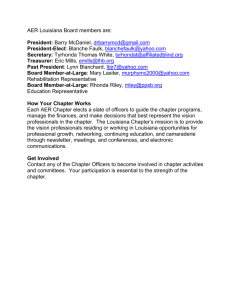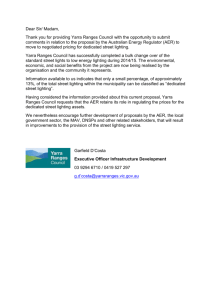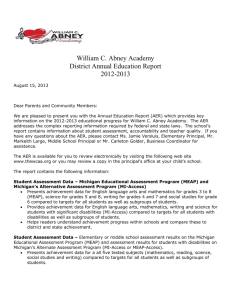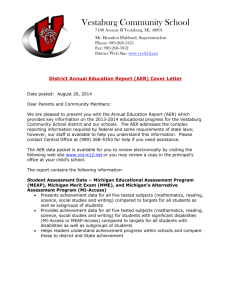Peace River Proceeding Recommendations Status Report as of July
advertisement
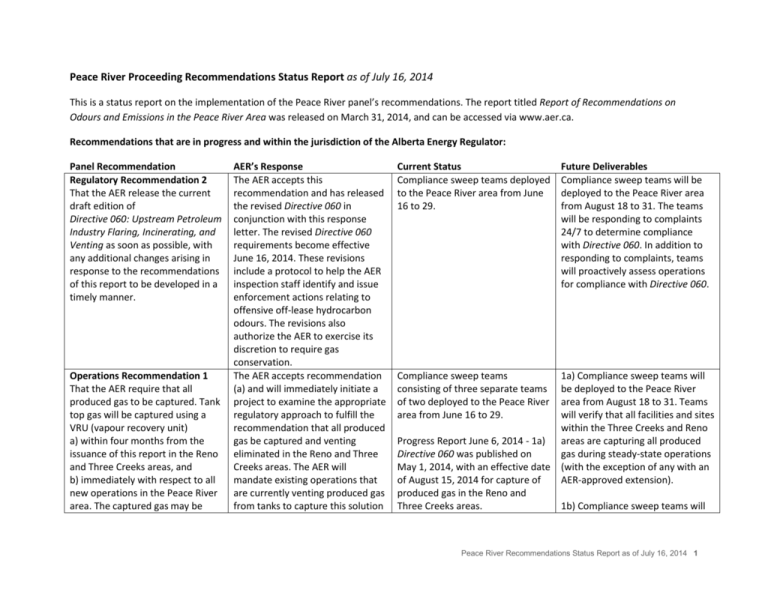
Peace River Proceeding Recommendations Status Report as of July 16, 2014 This is a status report on the implementation of the Peace River panel’s recommendations. The report titled Report of Recommendations on Odours and Emissions in the Peace River Area was released on March 31, 2014, and can be accessed via www.aer.ca. Recommendations that are in progress and within the jurisdiction of the Alberta Energy Regulator: Panel Recommendation Regulatory Recommendation 2 That the AER release the current draft edition of Directive 060: Upstream Petroleum Industry Flaring, Incinerating, and Venting as soon as possible, with any additional changes arising in response to the recommendations of this report to be developed in a timely manner. Operations Recommendation 1 That the AER require that all produced gas to be captured. Tank top gas will be captured using a VRU (vapour recovery unit) a) within four months from the issuance of this report in the Reno and Three Creeks areas, and b) immediately with respect to all new operations in the Peace River area. The captured gas may be AER’s Response The AER accepts this recommendation and has released the revised Directive 060 in conjunction with this response letter. The revised Directive 060 requirements become effective June 16, 2014. These revisions include a protocol to help the AER inspection staff identify and issue enforcement actions relating to offensive off-lease hydrocarbon odours. The revisions also authorize the AER to exercise its discretion to require gas conservation. The AER accepts recommendation (a) and will immediately initiate a project to examine the appropriate regulatory approach to fulfill the recommendation that all produced gas be captured and venting eliminated in the Reno and Three Creeks areas. The AER will mandate existing operations that are currently venting produced gas from tanks to capture this solution Current Status Compliance sweep teams deployed to the Peace River area from June 16 to 29. Future Deliverables Compliance sweep teams will be deployed to the Peace River area from August 18 to 31. The teams will be responding to complaints 24/7 to determine compliance with Directive 060. In addition to responding to complaints, teams will proactively assess operations for compliance with Directive 060. Compliance sweep teams consisting of three separate teams of two deployed to the Peace River area from June 16 to 29. 1a) Compliance sweep teams will be deployed to the Peace River area from August 18 to 31. Teams will verify that all facilities and sites within the Three Creeks and Reno Progress Report June 6, 2014 - 1a) areas are capturing all produced Directive 060 was published on gas during steady-state operations May 1, 2014, with an effective date (with the exception of any with an of August 15, 2014 for capture of AER-approved extension). produced gas in the Reno and Three Creeks areas. 1b) Compliance sweep teams will Peace River Recommendations Status Report as of July 16, 2014 1 Panel Recommendation sent to a flare or incinerator until the feasibility study (discussed in recommendation 5 of the Operations section) is implemented. Operations Recommendation 2 That each operator in the Seal Lake and Walrus areas provide a report to the AER within two months of the issuance of this report outlining its plan to install VRUs to eliminate venting from existing facilities. The Panel expects the AER, after considering the AER’s Response gas by August 15, 2014. The AER accepts recommendation (b). Effective May 15, 2014 the AER will require all new heavy oil and bitumen operations in the Peace River area to capture all produced gas during steady-state operations. The AER accepts this recommendation and will require operators from the Seal Lake and Walrus areas that are venting produced gas to submit a plan by June 15, 2014, demonstrating targeted actions to reduce and eventually eliminate venting. The AER will then work with operators Current Status Penn West was granted an extension for three facilities in the Three Creeks area to comply with regulatory requirement to capture all produced gas. One facility must be in compliance by September 30, 2014, the second facility must be in compliance by November 8, 2014, and the third facility must be in compliance by November 20, 2014. If odour complaints occur, it is important to note that any venting resulting in offensive hydrocarbon odours outside the lease boundary may result in AER enforcement action, as per section 8.2 of Directive 060 (in effect on June 16, 2014). 1b) Directive 056 was published on May 1, 2014 with an effective date of May 15, 2014 for all new heavy oil and bitumen operations in the Peace River area. Operators submitted implementation plans for the Seal Lake and Walrus areas to eliminate venting by June 15, 2014. Future Deliverables be deployed to the Peace River area from August 18 to 31. Teams will verify that all heavy oil and bitumen operations approved since May 15, 2014, are capturing all produced gas during steadystate operations. AER staff will assess the implementation plans and are in discussions with operators. Peace River Recommendations Status Report as of July 16, 2014 2 Panel Recommendation information in such reports, to work with operators to implement an appropriate and timely plan to eliminate venting. Operations Recommendation 5 That towards the objective of conserving all captured gas, the AER require that by October 31, 2014, operators, either collectively or independently, provide a feasibility study to the AER into options and timelines to conserve all gas at sites in the Peace River area. The Panel expects that the AER, after considering the information in the feasibility study, will require operators to implement an appropriate conservation plan. Geology Recommendation 1 That the AER conduct or require operators in the Peace River area to submit a geochemical analysis of the volatile compounds from the heavy oil from the Gordondalesourced bitumen a) at surface prior to processing, AER’s Response and stakeholders to design an appropriate regulatory approach that will be implemented as soon as reasonably practical with the outcome of reducing and eventually eliminating the venting of produced gas from existing heavy oil and bitumen operations in the Seal Lake and Walrus areas. The AER accepts the recommendation. Once the review and analysis of the feasibility study is complete, the AER will require operators in the Peace River area to implement an appropriate gas conservation plan. With the revised Directive 060, the AER will have the regulatory tools in place to require conservation. Current Status Future Deliverables Letters requesting implementation plans for the conservation of all produced gas in the Peace River area (Three Creeks, Reno, Seal Lake, and Walrus) were sent to operators in the area on June 2, 2014. AER staff to contact operators in September 2014 to check on progress. The AER accepts this recommendation. The results of 1(a) will define the boundary of the play for regulatory recommendation 1. The results of 1(a) and 1(b) will characterize the produced hydrocarbons over the production cycle. The recommendation will require 1a) A draft geological model of the petroleum systems in the Peace River area is complete. The model is currently being used by a geochemist to develop a sampling program for petroleum at the wellhead. 1b) The AER has finished consulting with a geochemist and Based on the geological model, analysis of the geological data, consultation with a geochemistry expert, and analysis of a large amount of geochemical research in the public domain, large-scale wellhead and production facility sampling will not enable differentiation of hydrocarbon Feasibility studies are due to the AER by October 31, 2014. Peace River Recommendations Status Report as of July 16, 2014 3 Panel Recommendation and b) from the tank prior to transport. AER’s Response the AER to specify the sampling program and laboratory protocols for consistency; and the samples need to be collected by the operators, although supportive core sampling may be done by the AER. The AER will immediately initiate a review of AER regulatory approaches to enable the collection of the geochemical analysis. Current Status has determined that sampling petroleum over the production cycle (would not be sufficient for regulatory differentiation. Future Deliverables geochemical plays sufficient for regulatory differentiation. This means that 1(a)—a detailed sampling program of pools/plays associated with Gordondale petroleum systems— will not proceed, and 1(b)—the sampling of production facilities to identify chemical evolution of Gordondalesourced heavy oils and bitumen— will not proceed. Supplementary sampling will be limited to about 10 samples to characterize Gordondale- and Exshaw-sourced hydrocarbons to characterize hydrocarbon end members and mixed-source compositional variations. Since the AER will be conducting the sampling, operators will not receive notification. Stakeholder Engagement Recommendation 1 That the AER provide support to allow stakeholders to work together and determine what The AER accepts this recommendation and will continue to facilitate stakeholder engagement. On June 18, the AER provided local operations staff the opportunity to learn on site about Directive 060 and the Hydrocarbon Odour Management Protocol. A geological report will be issued by November 30, 2014, describing the model of geological plays and the geochemical play boundaries to support regulatory responses. The AER will continue to provide on-site opportunities for local operations staff to learn about Directive 060 and the Hydrocarbon Odour Management Protocol Peace River Recommendations Status Report as of July 16, 2014 4 Panel Recommendation AER’s Response stakeholder engagement processes would meet their needs on a goforward basis. Stakeholder Engagement Recommendation 2 That the AER enhance its operational and enforcement presence in the Peace River area. The AER accepts this recommendation. The AER intends to develop a strategic and focused surveillance program for the Peace River area. Surveillance will focus on compliance, education, and prevention. Operations Recommendation 3 That, following implementation of The AER accepts this recommendation. The AER Current Status On June 19, the AER hosted a meeting at McKenny Hall in Peace River for residents and municipalities. Peace River residents who provided the AER with contact information and were seeking additional information were emailed a link to information on the compliance sweep. On June 16–29 the sweep teams provided 24/7 complaint response to verify compliance with Directive 060. Between June 16 and 20 and June 23 and 27, additional sweep teams were brought in to verify that heavy oil and bitumen operations approved since May 15, 2014, are capturing all produced gas during steady-state operations. On July 9, 2014, letters were sent to operators directing that they Future Deliverables during proactive inspections. Compliance sweep teams will be deployed to the Peace River area for both announced and unannounced verification periods. From August 18 to 31, the sweep teams will provide 24/7 complaint response to verify compliance with Directive 060. From August 18 to 22 and August 25 to 29, additional sweep teams will be brought in to verify that heavy oil and bitumen operations approved since May 15, 2014, are capturing all produced gas during steady-state operations and to verify that all facilities and sites within the Three Creeks and Reno areas are capturing all produced gas during steady-state operations (with the exception of any with an AER-approved extension). AER staff to contact operators in August 2014 to check on progress. Peace River Recommendations Status Report as of July 16, 2014 5 Panel Recommendation gas capture measures contemplated in these recommendations, the AER prohibit venting from all facilities. In the event of an emergency or upset situation and where flaring infrastructure is not available (which results in venting), the well must be immediately shut in. Operations Recommendation 4 That where gas conservation measures have been implemented, and where upsets and/or emergencies occur, the AER require that flaring be limited to a maximum of three per cent of the annual operational time, with the duration of the flaring reported to the AER monthly. Operations Recommendation 6 That the AER require that operators conduct monthly fugitive emission inspections using appropriate equipment (e.g., FLIR camera). The results of monthly fugitive emission inspections must be submitted to the AER for review and made available to area stakeholders. AER’s Response recognizes that the implementation of operations recommendations 1 and 2 will reduce and eventually eliminate venting in the Peace River area. Additionally, the AER will examine regulatory approaches to address venting in emergency or upset situations where flaring infrastructure is not available in the Peace River area. The AER accepts this recommendation and will examine the appropriate regulatory approach to ensure that flaring be limited to a maximum of three per cent of the annual operational time in the event of an upset or emergency where gas conservation measures have been implemented. Current Status provide the AER with a detailed plan demonstrating how venting would be eliminated from emergency or upset conditions in the Three Creeks and Reno areas. Future Deliverables On July 9, 2014, letters were sent to operators who are conserving gas to provide the AER information that includes a plan that demonstrates how upset and/or emergency flaring will not exceed three per cent of the annual operating time. AER staff to contact operators in August 2014 to check on progress. The AER accepts this recommendation and will develop an appropriate regulatory approach that will require Peace River area heavy oil and bitumen operations, as soon as reasonably practical, to conduct monthly fugitive emission inspections and to report the results to the AER. The AER will make the results of the monthly inspection reports available to the public. On July 9, 2014, letters were sent to operators requesting that they provide the AER information on fugitive emissions from processes at Peace River facilities and leak detection and repair information for Peace River facilities. Information on fugitive emissions is due to the AER by July 25, 2014. Detailed plans are due to the AER by September 30, 2014. Information and plans are due to the AER by September 30, 2014. Information on available leak detection and repair information is due to the AER by July 31, 2014. Peace River Recommendations Status Report as of July 16, 2014 6 Panel Recommendation Operations Recommendation 7 That the AER require that where sources of fugitive emissions are identified, these be repaired within 12 hours of being detected or the facility be shut down until such repairs are completed. Repair responses would be submitted to the AER for review and made available to area stakeholders. Operations Recommendation 8 That the AER require that operators implement measures (such as scrubbing or recovering displaced truck tank emissions) to minimize odours from truck loading and unloading activities. AER’s Response The AER accepts this recommendation’s outcome. For the purposes of this recommendation, fugitive emissions are defined as follows: “Fugitive emissions at oil and gas facilities are unintentional leaks to the atmosphere and arise due to normal wear and tear on seals, threaded or mechanical connections, covers, or other equipment components.” The AER will develop the appropriate regulatory approach to ensure that operators repair identified sources of fugitive emissions, as defined, as soon as reasonably practical and report to the AER on the repair response. The AER will make this information available to the public. The AER accepts this recommendation’s outcome but recognizes that the AER’s jurisdiction applies only to AERlicensed wells and facilities. The AER will evaluate and implement appropriate regulatory approaches to minimize emissions and odours associated with truck loading and unloading activities. For sites not licensed with the AER, the AER will engage with the appropriate parties to discuss strategies to Current Status On July 9, 2014, letters were sent to operators requesting that they provide the AER information on fugitive emissions from processes at Peace River facilities and available leak detection and repair information for Peace River facilities. Future Deliverables Information on fugitive emissions is due to the AER by July 25, 2014. Information on available leak detection and repair information is due to the AER by July 31, 2014. Project has not yet begun. Peace River Recommendations Status Report as of July 16, 2014 7 Panel Recommendation Operations Recommendation 9 That the AER should review the results of the Stantec and Clearstone studies and a) require operational changes in the Three Creeks area, if necessary, to reduce odours and emissions from sources identified in those studies; b) determine the applicability of the results and operational changes to the other Peace River areas. Monitoring and Modelling Recommendation 1 That the AER engage industry, residents, and stakeholders to establish a scientific and technically credible regional air quality program for the Peace River area that, to the extent possible, a) builds on the efforts of the existing continuous monitoring program; b) includes the Reno area; c) considers the studies and monitoring surveys conducted to date by Alberta Environment and Sustainable Resource Development (ESRD), AER’s Response minimize odours from these activities. The AER accepts this recommendation and will review the studies. The AER will evaluate recommendations from these reports and, if necessary and appropriate, require Three Creeks– area operators to implement additional operational changes to reduce odours and emissions from sources identified in these reports. Knowledge from these reports will be applied to the other Peace River areas if appropriate. The AER accepts this recommendation and will immediately engage with industry, residents and stakeholders to establish a regional air quality monitoring program for the Peace River area. The AER will also expand its engagement to ESRD and Alberta Health. Current Status Future Deliverables Project team has been formed. The initial planning phases will begin in mid-July. Project team has been formed. The initial planning phases will begin in mid-July. Peace River Recommendations Status Report as of July 16, 2014 8 Panel Recommendation industry, Stantec, RWDI, Clearstone, Chemistry Matters, Odotech, and Dr. Zelt; d) provides greater geographic and spatial coverage by monitoring in areas of anticipated highest concentrations and where people might be exposed to emissions and odours; e) is operated collaboratively by industry, residents, the AER, and other government agencies (using a Clean Air Strategic Alliance [CASA] type model); f) provides transparent and realtime data to residents and stakeholders; and g) assesses innovative monitoring technologies to better understand odours and emissions sources and use the technology where appropriate. Monitoring and Modelling Recommendation 2 That the AER require that holders of new approvals issued in the Peace River area join the regional monitoring program. Monitoring and Modelling Recommendation 3 AER’s Response Current Status Future Deliverables The AER accepts the recommendation. The AER will require all new heavy oil and bitumen operations in the Peace River area to join the appropriate regional monitoring program as soon as reasonably practical. The AER accepts the recommendation and will Project team has been formed. The initiating and planning phase will begin in mid-July. Project team has been formed. The initiating and planning phase will begin in mid-July. Peace River Recommendations Status Report as of July 16, 2014 9 Panel Recommendation That the AER work with stakeholders engaged in the air quality monitoring program to provide a progress report to the Peace River area community within six months of the issuance of this report. The report should describe a) progress that has been made in establishing the governance framework for the monitoring program, b) progress that has been made in modelling or in characterizing emissions and odours, and c) other efforts made to address the monitoring recommendations above. Regulatory Recommendation 1 That the AER establish localized, “play-based” regulatory requirements for all heavy oil operations in the Peace River area that are producing or will produce Gordondale-sourced bitumen. AER’s Response collaborate with ESRD and Alberta Health to provide a progress report on air quality monitoring in the Peace River area. Current Status The AER accepts this recommendation and will examine opportunities to develop a playbased regulatory (PBR) approach in the Peace River area. The AER is currently considering applying a PBR approach to other areas of the province. This would involve designing unique regulatory frameworks for areas that have unique risk profiles with the intention of achieving assurance of broad economic, environmental, and social policy goals. Play-based regulation would include Project has not yet begun. Future Deliverables Peace River Recommendations Status Report as of July 16, 2014 10 Panel Recommendation AER’s Response regulatory approaches to address risks to outcomes specific to the Peace River area. Current Status Future Deliverables Peace River Recommendations Status Report as of July 16, 2014 11

